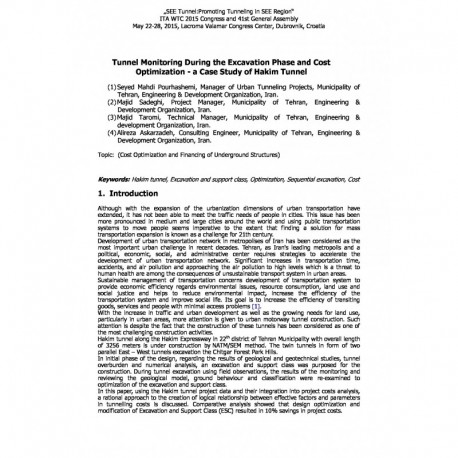Cart
0
0
No document
0,00 €
Total
Document successfully added to your shopping cart
Quantity
Total
There are 0 items in your cart.
There is 1 item in your cart.
Total documents
Total shipping
To be determined
Total
Search & filter
Search for a publication
Search & filter
Tunnel Monitoring During the Excavation Phase and Cost Optimization - a Case Study of Hakim Tunnel
full_paper
S. M. Pourhashemi / M. Sadeghi / M. Taromi / A. Askarzadeh
Although with the expansion of the urbanization dimensions of urban transportation have extended, it has not been able to meet the traffic needs of people in cities. This issue has been more pronounced in medium and large cities around the world and using public transportation systems to move people seems imperative to the extent that finding a solution for mass transportation expansion is known as a challenge for 21th century. Development of urban transportation network in metropolises of Iran has been considered as the most important urban challenge in recent decades. Tehran, as Iran's leading metropolis and a political, economic, social, and administrative center requires strategies to accelerate the development of urban transportation network. Significant increases in transportation time, accidents, and air pollution and approaching the air pollution to high levels which is a threat to human health are among the consequences of unsustainable transport system in urban areas. Sustainable management of transportation concerns development of transportation system to provide economic efficiency regards environmental issues, resource consumption, land use and social justice and helps to reduce environmental impact, increase the efficiency of the transportation system and improve social life. Its goal is to increase the efficiency of transiting goods, services and people with minimal access problems . With the increase in traffic and urban development as well as the growing needs for land use, particularly in urban areas, more attention is given to urban motorway tunnel construction. Such attention is despite the fact that the construction of these tunnels has been considered as one of the most challenging construction activities. Hakim tunnel along the Hakim Expressway in 22 district of Tehran Municipality with overall length of 3256 meters is under construction by NATM/SEM method. The twin tunnels in form of two parallel East – West tunnels excavation the Chitgar Forest Park Hills. In initial phase of the design, regarding the results of geological and geotechnical studies, tunnel overburden and numerical analysis, an excavation and support class was purposed for the construction. During tunnel excavation using field observations, the results of the monitoring and reviewing the geological model, ground behaviour and classification were re-examined to optimization of the excavation and support class. In this paper, using the Hakim tunnel project data and their integration into project costs analysis, a rational approach to the creation of logical relationship between effective factors and parameters in tunnelling costs is discussed. Comparative analysis showed that design optimization and modification of Excavation and Support Class (ESC) resulted in 10% savings in project costs.




